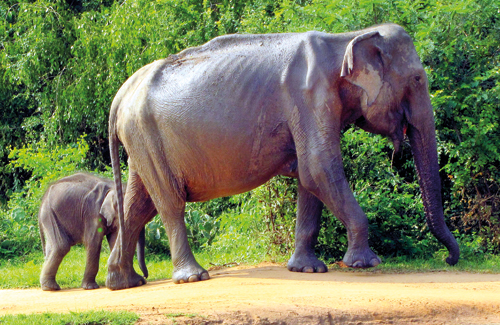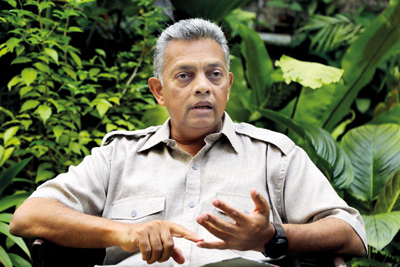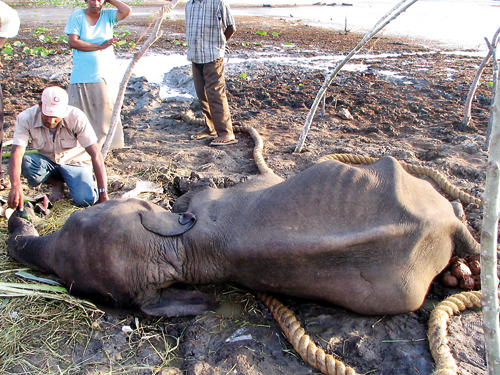Don’t drive our jumbos to death

Starving and skeletal mother and baby, Menika and Mandy at the Yala National Park. Photos courtesy the Centre for Conservation and Research
Humans and wild elephants have lived ‘together’ for aeons in Sri Lanka.
In fact, the country has bestowed upon elephants, domesticated ones of course, an honour not given to any other creature – that of carrying the Sacred Tooth Relic of Lord Buddha around the streets of Kandy to be venerated by large crowds.
As a country we are also unique – drawing in precious dollars as tourists converge here to see the largest land animal, the elephant in the wild and a little distance away the largest marine animal – the blue whale in the seas surrounding the country.
Where on earth, except in Sri Lanka, can one see a majestic elephant peacefully feeding in the jungles sandwiching the Dambulla-Habarana Road sending ripples of excitement among motorists and passers-by or as many as 300, mostly cow elephants and their babies, picking at the tasty morsels of tender grass which carpet the Minneriya and Kaudulla tank-beds, as “oohs” and “aahs” emanate from both locals and foreigners at such a “spectacular” sight?
Over the years though, with unplanned expansion of human habitats and development into the homes of these animals, there has been conflict between human and elephant.
How, as a nation, should Sri Lanka go about mitigating the Human Elephant Conflict (HEC)?
The answer is simple and obvious – go by evidence-based knowledge gathered over the years and learn through bitter lessons from previous actions which have had disastrous consequences. (Please see the images)
So the humble plea from all those lovers not only of wild elephants but all animals is: “Let’s not repeat the tragic mistakes made earlier. Let’s not go back to square one, as we have enough evidence to move forward where both humans and wild elephants can live together, with a little adjustment.”

Dr. Sumith Pilapitiya
And such a plea is for selfish reasons as well – because we need to keep the ecosystem balance for the very survival of humans!
In an exclusive interview with the Sunday Times on ‘HEC Management – Will we ever learn from our past mistakes?’ the former Director-General (DG) of the Department of Wildlife Conservation (DWC), Dr. Sumith Pilapitiya stressed that studies in Sri Lanka have shown that ‘translocation’, ‘drives’ and ‘confinement’ are not a viable management strategy and will jeopardize the survival of Sri Lanka’s elephants, both within and outside the Protected Areas (PAs).
“There will be no benefit towards reducing the HEC,” Dr. Pilapitiya was emphatic, just a few days before he was scheduled to give a public lecture.
Elephant habitats are declining and the frequency and severity of the HEC are increasing, calling for alternative approaches to HEC management, he said.
Continuing to attempt to restrict elephants to PAs of the DWC will not reduce the HEC because it requires reducing their current habitat to about 30 percent of what they use at present. This cannot be done without killing over 4,000 elephants, it is learnt.
Dr. Pilapitiya is crystal clear in his explanation: “Most National Parks (which are part of the PAs) are already at or even beyond carrying capacity and hold the maximum number of elephants they can support. Additionally, National Parks are generally primary or mature forests providing only sub-optimal habitats for edge species, such as elephants. Elephant density in primary/secondary forests is 0.2 elephants per square kilometre, while savannah grasslands and scrub jungle can retain around 3 elephants per square kilometre. Since the DWC’s PAs have minimal human intervention, biological succession results in the conversion of degraded lands within PAs into secondary forests. Therefore, the DWC’s PAs are unable to carry a high density of elephants.”
The situation in Uda Walawe National Park is a case in point, he says citing an example.
Minneriya, Kaudulla and Maduru Oya are National Parks that are exceptions due to their habitat being largely grasslands. The primary reason for elephants to gather in such large numbers on the Minneriya and Kaudulla tank-beds is for the fodder they get from the grasslands, which are nourished by nutrient-rich sediments deposited there during the period of inundation. With the water from the reservoirs being released for agriculture, a growth of new and succulent grass emerges on the exposed tank-beds. This is why there are 300-400 elephants during ‘The Gathering’ in August and September, Dr. Pilapitiya points out. However, such parks also already carry the number of elphants they can support.
According to him, since the 1950s the strategy for HEC Management in Sri Lanka has been three-fold:
- Capture and translocate problem elephants;
- Conduct large-scale elephant drives in an attempt to move all elephants from the areas earmarked for development into PAs; and
- Confine the elephants within the PAs with barriers.
Had this strategy been successful, the HEC should have been solved or be on the decline. But the data indicate the opposite. Despite implementing this strategy for more than 50 years, a survey conducted by the Centre for Conservation and Research (CCR) has shown that there are elephants in 44% of the country that is outside PAs, says Dr. Pilapitiya, explaining that basically, these elephants are co-existing with humans, albeit with some level of conflict.

Kavan starving to death after being driven and fenced in at the Yala National Park
“While it may appear that humans and elephants can be separated, with elephants being confined to PAs, after more than 50 years of trying, if we realize that it cannot be done, there seems to be merit in re-evaluating and revising that strategy. The main reasons elephants cannot be limited to PAs are due to the PAs being at their carrying capacities. Elephants are also an ‘edge species’ and there is better elephant habitat outside. So it is not surprising that over two thirds of elephants live outside the areas controlled by the DWC.
Dr. Pilapitiya is quick to point out that research has shown that elephant drives, conducted mainly in response to political and social pressures have failed to eliminate crop raiding elephants from the drive areas. While herds composed of females and young tend to be driven, the crop raiding males often remain behind.
Communities have confirmed that elephants remaining after drives become more aggressive and develop into a bigger threat to people. Construction of electric fences along the administrative boundaries of the DWC PAs has failed to yield the expected outcome of HEC mitigation, since DWC PAs are often surrounded by elephant habitat. Therefore, this results in elephants being on both sides of the fence and fence breaking by elephants, it is understood.
Realizing this, the DWC led a multi-stakeholder process to develop a National Elephant Conservation Policy, says Dr. Pilapitiya, adding that it was approved by the Cabinet of Ministers in 2006. The policy states that “when elephants lose their range, they die”.
It further adds: “The prospects for long-term survival for the elephant in Sri Lanka are good. There is already a well-established PA network, which supports a proportion of the elephant population. However, a significant proportion of the elephant population ranges outside of the PAs. Ensuring the future survival of elephants that range inside and outside PAs is both central and crucial to the conservation of elephants.”
Dr. Pilapitiya stresses that if Sri Lanka is serious about the conservation of elephants in the wild, we should learn from our mistakes and past experiences and implement the provisions of the Cabinet-approved policy and not try to limit elephants to the DWC PAs.
| Weapons needed for battle against poachers; but AK 47 not the answer The former DWC DG Dr. Sumith Pilapitiya will deliver a Lecture on ‘Human Elephant Conflict Management – Will we ever learn from our past mistakes?’ on October 18 (Thursday) at 6 p.m. at the Jasmine Hall, BMICH, Colombo 7. Organized by the Wildlife and Nature Protection Society (WNPS), the lecture is open to members and non-members and entry is free of charge. Prior to the lecture next week, when asked by the Sunday Times as a former DWC DG, what he thinks of the DWC need to procure 2,567 AK 47 assault rifles, Dr. Pilapitiya said: “I feel that DWC officers need weapons more sophisticated than the repeater shot guns they have at present, for anti-poaching operations because currently some poachers are better armed than DWC officers. The DWC has lost officers in battles with poachers. However, I am no weapons expert. So, I am not sure whether the most suitable weapon is an AK 47.” To the query that the Cabinet Paper of July 18, 2018 is not on anti-poaching, but requests that these weapons be procured for HEC management and what his views are, he said that the HEC has two participants — humans and elephants. As officers of the DWC whose mandate is to conserve wildlife, no officer should be shooting an elephant. “This means that the weapon could be to deal with the other stakeholder, who is a human. DWC officers cannot shoot people either, so I am at a loss to understand why such a sophisticated weapon is needed. For personal protection, DWC officers may need a weapon but in my opinion, it should not be a weapon that could kill an elephant instantly,” added Dr. Pilapitiya who is an Environmental Scientist. Dr. Pilapitiya briefly held the post of DWC DG before resigning on “matters of principle”. He is researching elephant social behaviour in the Yala, Minneriya and Kaudulla National Parks and their surrounding landscapes. Echoing serious concerns about suggestions to restrict all wild elephants to PAs, the Head of the Centre for Conservation and Research (CCR), Dr. Prithiviraj Fernando said that such was the thinking about 50 years ago, which led to an increase in the HEC and “killed lots of elephants”. Modern research has shown the way and that’s why the National Elephant Conservation Policy was developed in 2006, says Dr. Fernando, painting grim images of the results of ‘limiting’ wild elephants to PAs. “The elephants driven and restricted to PAs, which would mostly be non-problem causing cow elephants and their babies, as well as elephants that were in the PAs, starve to death due to exceeding of the carrying capacity,” he said with emotion, pointing out that the elephants which are left behind in human habitation areas after drives, become very aggressive because they were very fearful of humans after being severely harassed by humans in their bid to relocate them. Hence, the HEC increases in drive areas. Going back to attempts to restrict elephants to PAs will severely escalate the HEC and kill lots of females and young ones, reasons Dr. Fernando, appealing to the authorities not to revisit such disastrous attempts. “It will also nullify all the forward steps taken in mitigating the HEC and send Sri Lanka down a very slippery slope, having a severe adverse impact on elephant conservation.” | |


